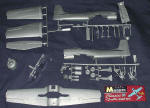
| KIT: | Monogram Classics 1/48 T-28A Trojan |
| KIT #: | 0028 |
| PRICE: | $9.98 when new (1999 reissue) |
| DECALS: | One option |
| REVIEWER: | Scott Van Aken |
| NOTES: | Includes collectors patch |

| HISTORY |
Originally designed for the USAF as a supplement and replacement for the AT-6 Texan, the T-28A was powered by an R-1300 engine which provided 800 hp and drove a two bladed propeller. It had nose wheel landing gear as it was to be the next step up to flying the Air Forces increasing crop of jet aircraft, all of which were tricycle landing gear. Even the cockpit was reminiscent of a jet.
Thanks to its design, it was a very forgiving aircraft that had outstanding flying characteristics. Just what was needed for a learning pilot. The greatest user of the T-28 was the US Navy, but they opted for a larger engine in theirs and operated the type as a trainer and hack into the 1970s. The USAF, however, had decided to go all jet in its training so most of their T-28s were out of the service by the end of the 1950s. Many T-28As were re-engined with the same power plant as in the Navy's T-28B/C aircraft and sold to the French as the Fennec. There, they were used as COIN aircraft in their African wars. The Fennec can be differentiated from a T-28B/C/D by its taller canopy and small air intake scoop just ahead of the windscreen. There are a few T-28As flying today as warbirds.
| THE KIT |
 If
you are looking for state of the art, then look elsewhere. However, if you
want an early T-28 then this is the only kit around. Typical of Monogram
kits of the time, it has several operating features, including retractable
landing gear and opening canopy. Actually, only the aft canopy moves, which
is a bit odd. You'll also need a LOT of nose weight (which you'll be able
to clearly see through the gear openings), as this aircraft is a real
tail-sitter. External detail isn't bad at all with finely raised detail and
the usual rivets. The kit does suffer from some sink area opposite
alignment pins so all isn't' roses. Hatches are engraved and there is
rather prominent markings where the rockets on later versions would attach.
If
you are looking for state of the art, then look elsewhere. However, if you
want an early T-28 then this is the only kit around. Typical of Monogram
kits of the time, it has several operating features, including retractable
landing gear and opening canopy. Actually, only the aft canopy moves, which
is a bit odd. You'll also need a LOT of nose weight (which you'll be able
to clearly see through the gear openings), as this aircraft is a real
tail-sitter. External detail isn't bad at all with finely raised detail and
the usual rivets. The kit does suffer from some sink area opposite
alignment pins so all isn't' roses. Hatches are engraved and there is
rather prominent markings where the rockets on later versions would attach.
You do get a fairly well done interior with raised detail on the side consoles and seat/stick for the back seater. Instrument panels are decals. The pilot for the front seat comes molded in his seat with his control stick in hand. A second pilot in the process of climbing aboard as well as a ground crewman with a fire extinguisher is provided as well.
 Instructions
are a copy of the original though the painting guide has been updated and
the usual warnings incorporated to take care of the sue-crazy. Markings are
provided for two overall bare metal aircraft. Though the box art shows one
with yellow wing tips, that isn't shown in the painting diagrams. If you
want to do something a bit different, these planes were also in overall
yellow and some of the bare metal planes had large areas of da-glo red on
the extremities of the flight surfaces. The decals themselves are well
printed and glossy. These are newer generation R-M decals so should work
just fine. Included is a collectors patch, which I guess is nice for those
who like such things.
Instructions
are a copy of the original though the painting guide has been updated and
the usual warnings incorporated to take care of the sue-crazy. Markings are
provided for two overall bare metal aircraft. Though the box art shows one
with yellow wing tips, that isn't shown in the painting diagrams. If you
want to do something a bit different, these planes were also in overall
yellow and some of the bare metal planes had large areas of da-glo red on
the extremities of the flight surfaces. The decals themselves are well
printed and glossy. These are newer generation R-M decals so should work
just fine. Included is a collectors patch, which I guess is nice for those
who like such things.
| CONCLUSIONS |
These reissued oldies are a real trip into the past for many of us and undoubtedly their attraction. Those who really want to make a nice model out of these can easily do so with a bit of additional work and research. I don't know if anyone out there will be doing a modern version of these planes, though it would be quite nice.
Kit courtesy of me.
If you would like your product reviewed fairly and quickly by a site that has over 250,000 visitors a month, please contact me or see other details in the Note to Contributors.